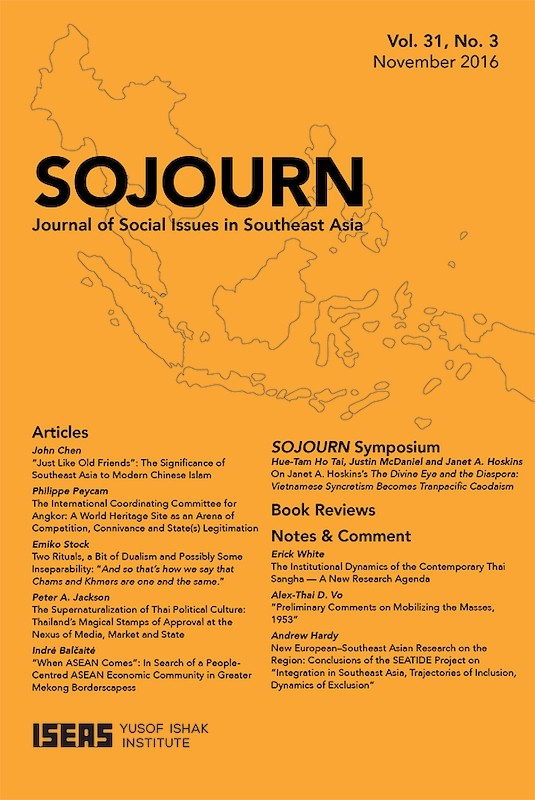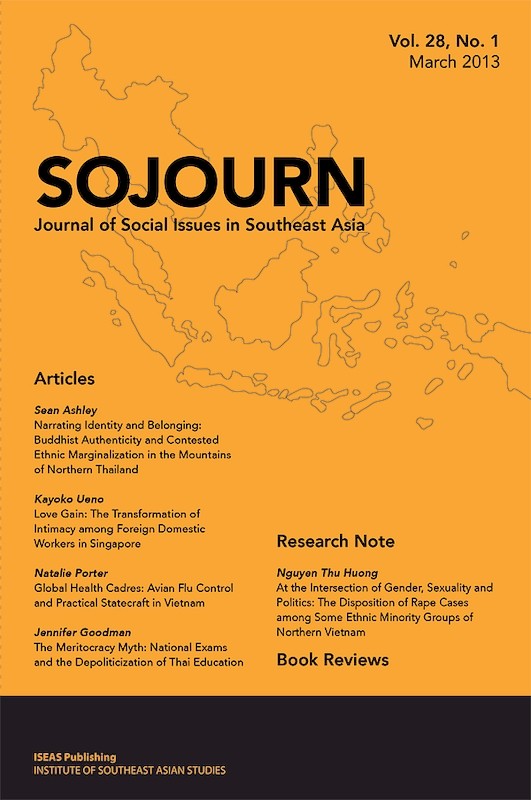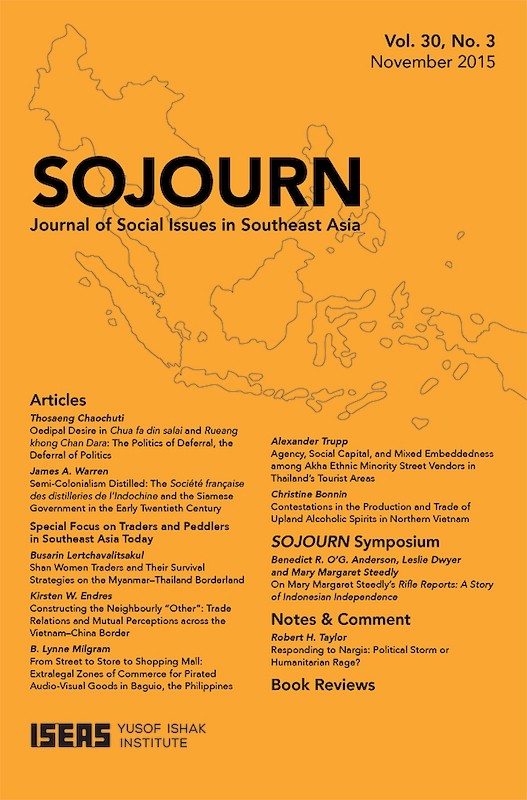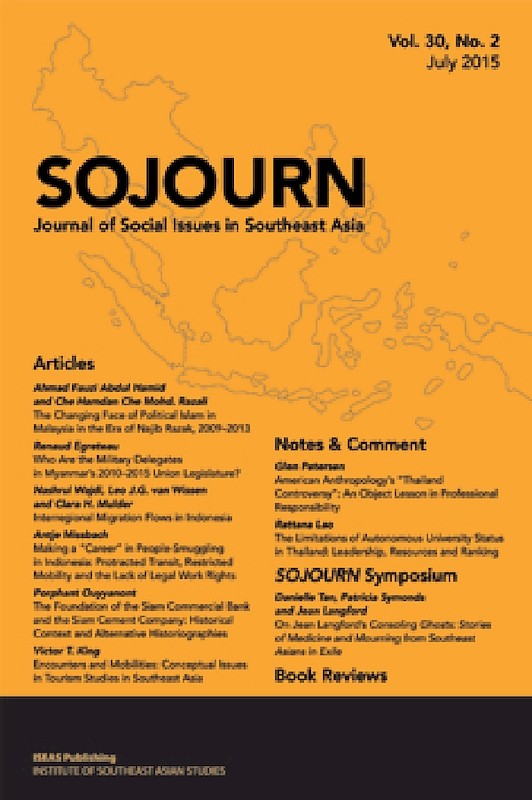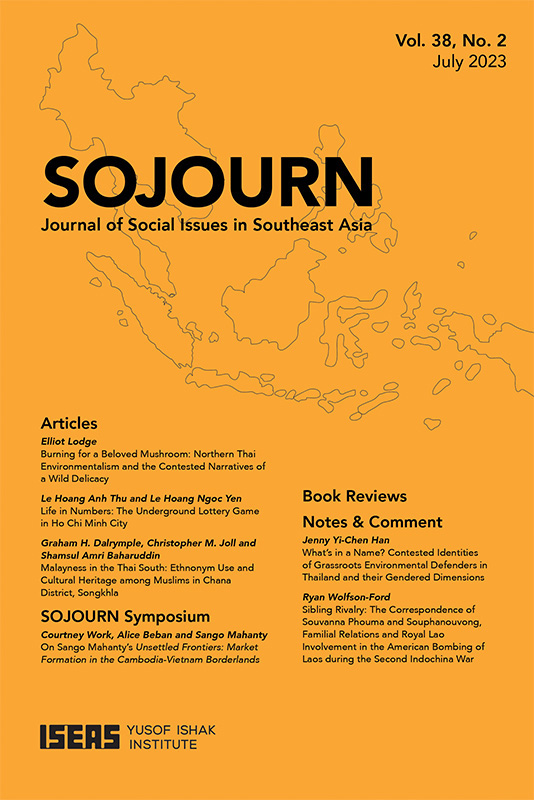SOJOURN: Journal of Social Issues in Southeast Asia Vol. 29/3 (November 2014)
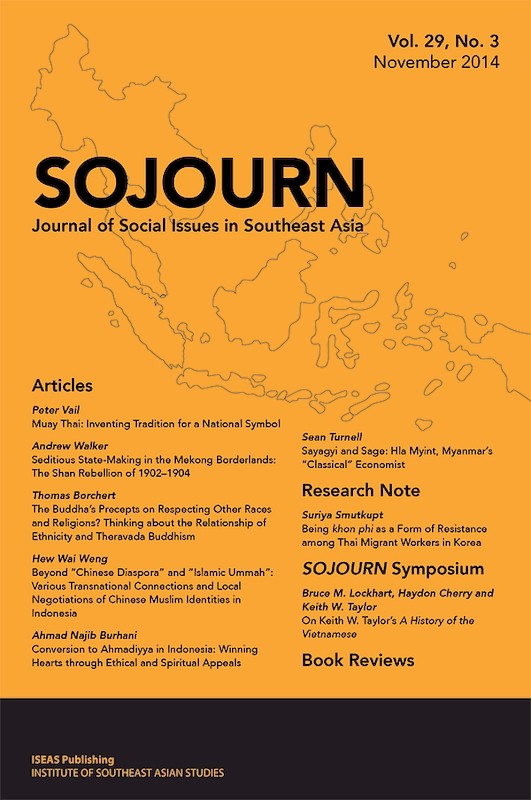
Date of publication:
November 2014
Publisher:
Institute of Southeast Asian Studies
Number of pages:
270
Code:
SJ29/3
Contents
-
SOJOURN: Journal of Social Issues in Southeast Asia Vol. 29/3 (November 2014)
[Whole Publication, ISSN: 17932858] -
Preliminary pages
- ARTICLES
-
Muay Thai: Inventing Tradition for a National Symbol, by Peter Vail, author see abstractMuay Thai is the national sport of Thailand and one of its major cultural exports. Scholars have paid little attention to Muay Thai in its role as national sport or to the cultural politicking that attends it. As Muay Thai becomes increasing popular internationally, conservative proponents of the sport in Thailand are reifying its history and inventing tradition to ensure that its Thai cultural trappings are not eroded. On the basis of a slim set of historical references, several Thai institutions — including government ministries and universities — characterize muay as an integral part of royalist national history, and concretize those characterizations in the form of museums, academic institutionalization and the registration of Muay Thai as intangible cultural heritage.
-
Seditious State-Making in the Mekong Borderlands: The Shan Rebellion of 1902-1904, by Andrew Walker, author see abstractA study of the Shan rebellion which broke out in the northern Siamese town of Phrae in July 1902 and continued until May 1904 serves as the basis for an exploration of the interaction between sedition and state-making in the Mekong borderlands at the turn of the twentieth century. French archival material makes clear that the rebellion was not just a two-dimensional struggle between discontented Shan and the expanding Siamese state, as it has been commonly understood. Rather, the rebellion was a multifaceted encounter with competing processes of state-making in the borderlands of Siam, Burma and French Indochina. The French sources show how the Shan rebels attempted to mobilize precolonial political alliances that extended well beyond the boundaries of Siam. They also show how the rebellion intersected productively with the recently established border between Siam and French Indochina. Modern borders are often portrayed as constraining the lives of borderlanders, but this marker of modern state power provided the rebellious Shan with sites of strategic refuge and tactical manoeuvre. Sedition and state-making were closely intertwined.
-
The Buddha's Precepts on Respecting Other Races and Religions? Thinking about the Relationship of Ethnicity and Theravada Buddhism, by Thomas Borchert, author see abstractTheravada Buddhism is often practised in contexts of significant ethnic diversity in Southeast Asia, but much scholarship has not sufficiently accounted for the role of this diversity in shaping the imagination of Theravada Buddhism among its practitioners in the region. Examination of Theravada Buddhist communities in the three very different contexts of Singapore, Southwest China and Thailand serves as the basis for consideration of this role. Despite the differences among these settings,<br>Theravada Buddhism in each is shaped by state discourses on race and religion. The ways in which Theravada Buddhism and ethnicity in both local and state forms mark each other merits more attention.
-
Beyond "Chinese Diaspora" and "Islamic Ummah": Various Transnational Connections and Local Negotiations of Chinese Muslim Identities in Indonesia, by Hew Wai Weng, author see abstractGoing beyond the paradigm of a “Chinese Diaspora” and an “Islamic Ummah”, this article examines various transnational connections, translocal imaginings and local negotiations of Chinese Muslim identities in contemporary Indonesia. By constructing Chinese-style mosques, Chinese Muslim leaders have forged a distinctive translocal identity through transnational linkage with Muslims in China and reconfigured it within Indonesian contexts. This transnational imagining<br>is not a form of desire for return to China, but rather an effort to redefine Chinese Muslims’ social position in Indonesia. Moreover, a closer exploration of ordinary Chinese Muslims in Indonesia reveals that their transnational connections are not limited to Muslims in China, and their local participation is not limited to Chinese Muslim organizations.
-
Conversion to Ahmadiyya in Indonesia: Winning Hearts through Ethical and Spiritual Appeals, by Ahmad Najib Burhani, author see abstractWhat is the manner in which Qadiani Ahmadiyya have propagated their beliefs and teachings to Indonesian Muslims and the factors that have attracted people to this movement and led them to convert to Ahmadiyya? What are the social implications of conversion? There is a perception that people’s receptiveness to Ahmadiyya is due mainly to its modernist character. But for Indonesians Qadiani’s most attractive feature is not its modernist stance, but rather its followers’ belief in the coming of the Messiah, its close knit organization and its sober and passionate missionaries. In contrast to members of the Lahore branch of Ahmadiyya, known for its rational tendency, members of the Qadiani branch have in their efforts at propagation of the faith emphasized their distinctive beliefs, such as the natural death of Jesus and the caliphate system. Qadiani Ahmadiyya has also tended to be a mystical movement whose members have a strong belief in supernatural experiences and dreams. They use these experiences and dreams to show God’s preference for them and God’s interference in human relationships, as when God sides with them.
-
Sayagyi and Sage: Hla Myint, Myanmar's "Classical" Economist, by Sean Turnell, author see abstractBurmese economists have been unusually prominent contributors to the evolution of economic thought. Looming over all of them, however, is Hla Myint. An intellectual pioneer in the study of economic development, trade and the institutions that drive growth, he could have had a decisive influence on economic policymaking in Myanmar. Effectively forced into exile via a misguided reaction in Myanmar against the perceived economics of colonialism, he instead made<br>contributions that assumed a global importance. The principal ideas of Hla Myint may be located then within the discourse of “classical economics”, but they were also informed by the circumstances of the country of his birth. In 2012, over seventy years after he first took up his pen in Myanmar’s service, Hla Myint’s wise counsel was once again heard, with immediate effect, and newfound hope.
- RESEARCH NOTE
-
Being khon phi as a Form of Resistance among Thai Migrant Workers in Korea, by Suriya Smutkupt, author see abstractFieldwork on the lives of illegal Thai migrant workers, or khon phi, living in a designated multicultural zone for foreign industrial workers in the Republic of Korea is reported. The report draws on two month-long research trips, in March and April 2011 and April and May 2013. The phenomenon of khon phi characterizes not only Thai migrant workers but also Vietnamese, Chinese, and others interviewed during the research. It embodies illegal transnational migrant workers’ efforts to achieve their own version of “the Korean dream”, despite their failure to adhere to Korean quotas on foreign workers or to regulations and restrictions governing those workers’ activities. It is a concept that allows these illegal Thai and other foreign migrant workers to survive the hardship that they face in Korea. The focus<br>here is on cases of foreign workers from Thailand.
- SOJOURN SYMPOSIUM
-
A History of the Vietnamese, by Bruce Lockhart, Haydon Cherry, Keith W Taylor, authors
- BOOK REVIEWS
-
BOOK REVIEW: Finding Their Voice: Northeastern Villagers and the Thai State by Charles Keyes, by Nicholas Tapp, author
-
BOOK REVIEW: Ties that Bind: Cultural Identity, Class, and Law in Vietnams Labor Resistance by Tran Ngoc Angie, by Simon Clarke, author
-
BOOK REVIEW: Vietnamese-Chinese Relationships at the Borderlands: Trade, Tourism and Cultural Politics by Yuk Wah Chan, by Guanie Lim, author
-
BOOK REVIEW: Squatters into Citizens: The 1961 Bukit Ho Swee Fire and the Making of Modern Singapore by Loh Kah Seng, by Ho Chi Tim, author
-
BOOK REVIEW: The Evolution of a Muslim Democrat: The Life of Malaysia's Anwar Ibrahim by Charles Allers, by Ahmad Fauzi Abdul Hamid, author
-
BOOK REVIEW: Adat and Indigeneity in Indonesia: Culture and Entitlements between Heteronomy and Self-Ascription edited by Brigitta Hauser-Schublin, by Adam Tyson, author
-
BOOK REVIEW: Radical Traditions: Reimagining Culture in Balinese Contemporary Music by Andrew McGraw, by David Harnish, author
-
BOOK REVIEW: The Story of Việt Nam: From Prehistory to the Present by Shelton Woods, by Mok Mei Feng, author

